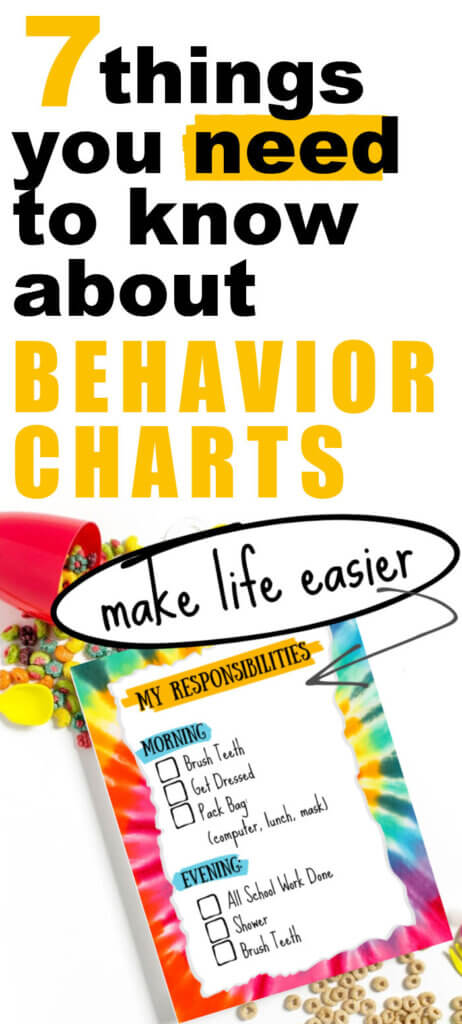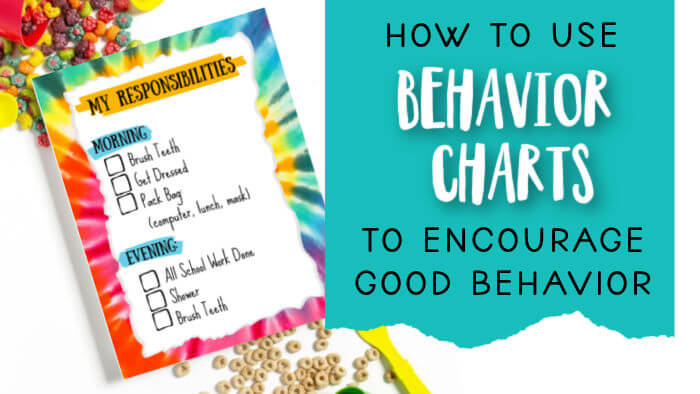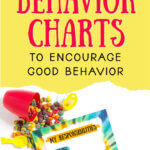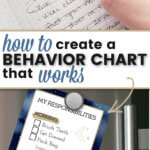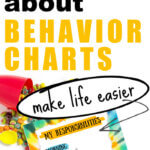Finding a way to encourage children to behave and do the things we need them to do can be challenging! You’ve probably heard that the best way to encourage good behavior is to use a lot of positive reinforcement.
One of the challenges to using positive reinforcement is that it requires you to be constantly watching and praising behaviors. (Honestly – it is just so much easier to notice the bad behaviors!)
If you are searching for a way to reinforce your child’s positive behavior as well as make it easier for you to provide positive reinforcement, then a behavior chart may be the answer. Utilizing behavior charts can be one of the best ways to formalize what behavior you are looking for and help you provide all of that positive reinforcement!
Behavior charts come in many different forms and are used for different purposes. One of the most common places where behavior charts or systems are used is within a classroom setting. Behavior Charts can also be used at home or in a childcare setting as well.
This article may contain affiliate links
Focus on Positive Reinforcement Instead of Shame
Before we jump into specifics on how to use a behavior chart to encourage good behavior, it is important to talk about the difference between positive reinforcement and shame based systems.
Behavior charts can tend to become full of shame – especially in a public setting like a classroom. It is easy for good intentions of providing rewards for positive behavior to end up turning into shaming kids for not earning rewards. (Not that parents or teachers mean to do this, but among peers and even in their own heads, children can fall into feeling shamed for not meeting their goals.)
Keep Behavior Charts Private
If you are using a behavior chart in a school setting, make sure to present and use the charts in a way that does not allow other children to see or become involved in whether or not the child is earning checks/stars, etc. This article perfectly explains why behavior charts should not be used publicly:
“Imagine seeing your bad day played out in bright colors on the very wall that all of your peers stare at all day long. These systems can leave students feeling worthless, overwhelmed and incapable.”
Katie Hurley, The Washington Post
Use Levels to Reach Rewards
In order to keep shame out of behavior systems and charts, I find that it is helpful to have different levels of rewards for compliance (for example a checkbox system where 3 checks earn extra storytime and 5 checks earns extra device time, etc.)
Use Flexibility in Your Approach to Behavior Charts
If possible, it is also great to have a lot of flexibility built into the chart so that you are able to talk about not reaching goals in a “you haven’t done it YET” mentality vs. a “you failed to meet your goal” mentality.
I use this type of flexibility at home with my kids by having a short list of items that need to happen (dressed, brush teeth, backpack packed, homework complete) before they earn device time for the day. If one of my kids is struggling, I am able to give them the flexibility and space to complete their tasks on their timeframe and/or as their choice.
If they are not getting their teeth brushed and we need to leave for school, it is very easy to present the task as a neutral choice rather than a reward/punishment. I would say something like: “We need to leave and you have not brushed your teeth yet. You can choose to go brush them so that you are on track to have device time when you get home, or you can choose to go to school without your teeth brushed but then there won’t be any device time when you get home.”

Identify Specific Goals
If you have decided to try a behavior chart, you will want to start by identifying some specific goals to work on. Make a list of problem behaviors or tasks that you want to address with your child(ren).
It is good to choose unambiguous goals. For example, Get Dressed and Brush Teeth by 7:30 am is better than Be Responsible. Or complete all daily class assignments is better than stay focused.
A good rule of thumb to help make sure you are using specific, unambiguous goals is to ask yourself – if a stranger read this goal, would they easily be able to tell if the goal was met?
Keep it Simple
When creating a list of goals and behaviors, you may find that you have 10, 20, or more items that you want to work on when it comes to your child. Having a complex, long behavior chart will get frustrating for you and your child.
It is best to choose 3-5 goals to work on with your child. (If your child is under 7 years old you will want to stick closer to 3 goals.)
To narrow it down, ask yourself these questions about your list:
- Is the goal specific and unambiguous?
- Can I easily determine if the goal has been met?
- Can I verify that the goal has been met quickly? (If it is something that you have to watch for all day long – like not calling names – it doesn’t belong on a behavior chart.)
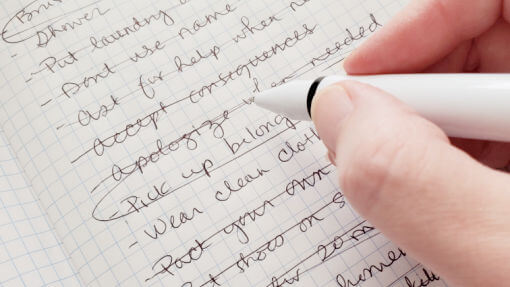
As a side note, you will most likely have some behavioral issues that really need to be addressed but that don’t fit well on a behavior chart. Keep in mind that a behavior chart is just one parenting or classroom management tool that you will use to address behavior. The more simple and easy the chart is to follow for you and the child, the more likely it will be to work!
Keep it Individualized if Possible
One of the problems with classroom behavior charts is that you have many different children with different abilities and struggles. The same can also be said for at home use if you are trying to use the same chart for different aged kids who have different personalities and needs!
If possible, create individualized behavior charts that focus on the individual child. This will help you target specific challenges as well as keep you out of the shame category by asking a child to do something that they are not as naturally or developmentally capable of as their peers or siblings.
It is okay to set some common goals, especially in a classroom setting. Try to also leave room to have at least one individual goal for each student or child. Or, if this will be too time-consuming, don’t use behavior charts with all students – just use them with the kids who need them.
If you are looking for other classroom management tools to compliment your behavior chart, make sure to check out the virtual calm down kit. This can be a great addition to your classroom management strategy!
Use Simple Rewards
It can be tempting to create a complex reward system that involves a great amount of time, energy, or resources. Work hard to come up with some simple, easy to provide rewards that will still motivate your children.
At home I love using rewards like device time, choosing what’s for dinner or breakfast, extra story time, and occasionally a small food reward.
This article has 30 ideas for one on one time that are all great options for time-based rewards.
In the classroom, the best rewards I have seen have been the use of mechanical pencils, the ability to take off shoes while working, and the ability to have extra free time at the end of the day.
Plan on Revisions
You will most likely need to revise your behavior chart for one of two reasons. First, you may find that the goals you chose are not specific enough, are too hard to monitor, or are just too hard for your child. (Try breaking hard goals into smaller goals.)
Second, you will hopefully get to a point where your child is consistently showing positive behavior and is ready to move on to another goal. After a couple of weeks of consistently meeting the goal, change up the goal so that your child stays interested.
Use a Behavior Chart Template or Printables
When it comes to what a behavior chart should look like, there are so many possibilities! Here are a few of my favorite options from Amazon:
This Magnetic Rewards Chart makes keeping up with goals and making revisions super easy.
This dry erase magnetic behavior board works for 2 kids and looks stylish enough to have on the fridge.
This dry erase self-adhesive pack of behavior charts would work well for classroom use.
Behavior Charts Can Encourage Positive Behavior
If used correctly, behavior charts can be a great parenting or classroom management tool. Make sure to follow these simple guidelines to ensure that your behavior chart will be the best it can be!
- Avoid Shame
- Identify Goals
- Keep it Simple
- Keep it Individualized
- Use Simple Rewards
- Plan on Revisions
- Use a Template or Printable
